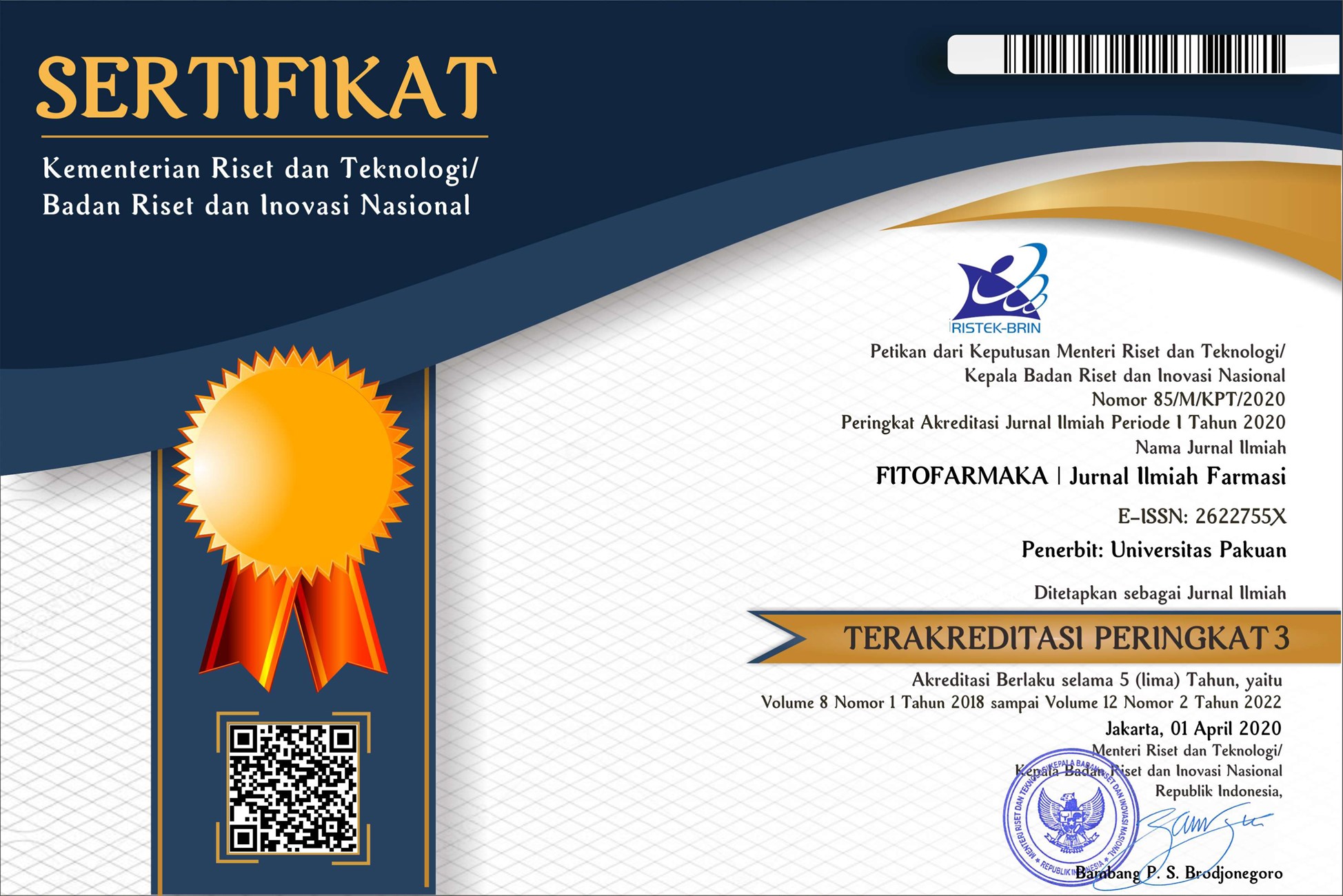Pancreatic Protection Effects of Butterfly Pea (Clitoria Ternatea) Flower Extract Against White Rattus Novergicus Induced By Alloxan
Abstract
The pancreas is an endocrine gland that produces the peptide hormones insulin, glucagon, and somatostatin, and also an exocrine gland that produces digestive enzymes. These hormones play an important role in regulating the body's metabolic activities, especially blood glucose homeostasis. The aim of this study was to investigate the ethanolic extract of butterfly pea flower (Clitoria ternatea L) against white rats (Rattus novergicus) induced by alloxan and to I the level of its damage. Fifteen male wistar rats (150-200 g) body weight (BW) were divided into 5 groups. The control healthy group, the placebo group and the extract treated group that received 150 mg/kg BW (group I), 300 mg/kg BW (group II) and 450 mg/kg BW (group III) orally. Placebo (Na-CMC) and extract were given for 5 consecutive days before alloxan administration (150 mg/kg BW) on days 6 and 7. Blood samples were taken to determine the glucose and albumin levels on day 0 (before treatment), on day 5 (after treatment of the extract but before the administration of alloxan), and on 6 and 7 after 24 h administration of alloxan. Alloxan induced gives a significant increase in glucose and albumin levels. The average of glucose level was 236.6±37.6 mg/dl in the health control, 252±28.1 mg/dl in the placebo group, 137±35.5 mg/dl in the extract of group I, 115.9±19.1 mg/dl in the extract of 300 mg of group II and 145.2±58.6 mg/dl of group III. Meanwhile the average of albumin level in the healthy group was 3.39±0.8 g/dl, the placebo group was 2.7±0.2 g/dl, the group I was 1.9±0.04 g/dl, the group II was 1.77±0.16 g/dl, and the group III was 1.85±0.19 g/dl. This study showed that at highest dose of C. ternatea was able to significantly prevent the elevation pancreatic damage biomarkers and this finding was associated with the result of histopathological analysis of the pancreas. These results suggest that the ethanol extract of C. ternatea at a dose of 450 mg/kg BW (group III) has a good protective effect on the function and structure of pancreatic tissue.
Keywords
References
Al-Snafi, A.E. (2016). Pharmacological Importane Of Clitonia ternatea – A review. IOSR journal of pharmacy, 6(3): 68-83.
American Diabetes Association. (2010). Diagnosis and Classification of Diabetes Mellitus. Diabetes Care, 33(S.1): 62-69. doi.org/10.2337/dc10-S062
Vetere, A., Choudhary, A., Burns, S.M., Wagner, B.K. (2014). Targeting the pancreatic β-cell to treat diabetes, Nature Reviews Drug Discovery. 13(4): 278–289. doi.org/10.1038/nrd4231
Aguayo-Mazzucato, C. & Bonner-Weir, S. (2018). Pancreatic β cell regeneration as a possible therapy for diabetes. Cell Metabolism, 27(1): 57–67.
doi.org/10.1016/j.cmet.2017.08.007
Djabir, Y.Y., Arsyad, A., Murdifin, M., et al. (2021). Kleinhovia hospita extract alleviates experimental hepatic and renal toxicities induced by a combination of antituberculosis drugs. Journal of Herbmed Pharmacology, 10(1): 102-108. doi.org/10.34172/jhp.2021.10
Eizirik, D.L., Colli, M.L., Ortis, F. (2009). The role of inflammation in insulitis and β-cell loss in type 1 diabetes. Nature Reviews Endocrinology, 5(4): 219–226.
doi.org/10.1038/nrendo.2009.21
Haythorne, E., Rohm, M., van de Bunt, M., et al. (2019). Diabetes causes marked inhibition of mitochondrial metabolism in pancreatic β-cells, Nature communications, 10(1): 2474.
doi.org/10.1038/s41467-019-10189-x
El-Shafey, M.M., Abd-Allah, G.M., Mohamadin A.M., Mohamadin, A.M., Harisa, G.I., Mariee, A.D. (2015). Quercetin protects against acetaminophen-induced hepatorenal toxicity by reducing reactive oxygen and nitrogen species. Pathophysiology, 22(1): 49-55. doi.org/10.1016/j.pathophys.2014.12.002
Entezari, M., Hashemi, D., Taheriazam, A., et al. (2021). AMPK signaling in diabetes mellitus, insulin resistance and diabetic complications: A pre-clinical and clinical investigation. Biomedicine & Pharmacotherapy, 146.
doi.org/10.1016/j.biopha.2021.112563
Francenia Santos-Sánchez, N., Salas-Coronado, R., Villanueva-Cañongo, C., Hernández-Carlos, B. (2019). Antioxidant Compounds and Their Antioxidant Mechanism. Antioxidants. doi.org/10.5772/intechopen.85270
Yaribeygi, H., Ashrafizadeh, M., Henney, N.C., et al. (2020). Neuromodulatory effects of anti-diabetes medications: a mechanistic review. Pharmacological Research, 152. doi.org/10.1016/j.phrs.2019.104611
Santin, I. & Eizirik, D.L. (2013). Candidate genes for type 1 diabetes modulate pancreatic islet inflammation and β-cell apoptosis, Diabetes, Obesity and Metabolism, 15(s3): 71–81.
doi.org/10.1111/dom.12162
Jeyaraj, E.J., Lim, Y.Y., Choo, W.S. (2021). Extraction Methods of Butterfly Pea (Clitoria ternatea) Flower and Biological Activities of Its Phytochemicals. Journal of food science and technology, 58(6): 2054-2067. doi.org/10.1007/s13197-020-04745-3
Beckman, J.A., Creager, M.A., Libby, P.J.J. (2002). Diabetes and atherosclerosis: epidemiology, pathophysiology, and management. JAMA, 287(19): 2570–2581. doi.org/10.1001/jama.287.19.2570
Forbes, J.M. & Cooper, M. (2013) Mechanisms of diabetic complications. Physiological Reviews, 93(1): 137–188. doi.org/10.1152/physrev.00045.2011
Zhang, J., Zhou, J., Zhang, T., et al. (2019). Facile fabrication of an amentoflavone-loaded micelle system for oral delivery to improve bioavailability and hypoglycemic effects in KKAy mice, ACS Appl. Mater. Interfaces, 11(13): 12904-12913. doi.org/10.1021/acsami.9b03275
Ashrafizadeh, M., Yaribeygi, H., Atkin, S.L., Sahebkar, A. (2019). Effects of newly introduced antidiabetic drugs on autophagy. Diabetes Metabolic Syndrome: Clinical Research Reviews, 13(4): 2445–2449.
doi.org/10.1016/j.dsx.2019.06.028
Mukherjee, P.K., Kumar, V., Kumar, N.S., Heinrich, M. (2008). The Ayurvedic Medicine Clitoria ternatea - From Traditional Use to Scientific Assessment. Journal of Ethnopharmacology, 120(3): 291–301. doi.org/10.1016/j.jep.2008.09.009
Stumvoll, M., Goldstein, B.J., van Haeften, T.W. (2005). Type 2 diabetes: principles of pathogenesis and therapy. Lancet, 365(9467): 1333–1346.
doi.org/10.1016/s0140-6736(05)61032-x
Shrestha, N., Araújo, F., Sarmento, B., Hirvonen, J., Sanntos, H.A. (2014). Gene-based therapy for type 1 diabetes mellitus: viral and nonviral vectors. Diabetes Management 4(4): 367–380.
doi.org/10.2217/dmt.14.31
Rahman, A.K.M.S., Saha, R., Talukder, N., Khaleque, S.M.A., Ali, H.A. (2006). Bioactivity Guided Cytotoxic Activity of Clitoria ternatea Utilizing Brine Shrimp Lethality Bioassay. Bangladesh J. Physiol. Pharmacol, 22, 18–21. doi.org/10.3329/bjpp.v22i1.3564
Wali, J.A., Milner, A.J., Luk, A.W., et al. (2021). Impact of dietary carbohydrate type and protein-carbohydrate interaction on metabolic health. Nature Metabolism, 3(6): 810-828. doi.org/10.1038/s42255-021-00393-9
Wang, L., Ma, R., Guo, Y., et al. (2017). Antioxidant effect of fructus ligustri lucidi aqueous extract in ovariectomized rats is mediated through Nox4-ROS-NF-κB pathway. Front Pharmacol, 8. doi.org/10.3389/fphar.2017.00266
DOI: 10.33751/jf.v13i1.6346
 Abstract views : 260
Abstract views : 260
Refbacks
- There are currently no refbacks.













